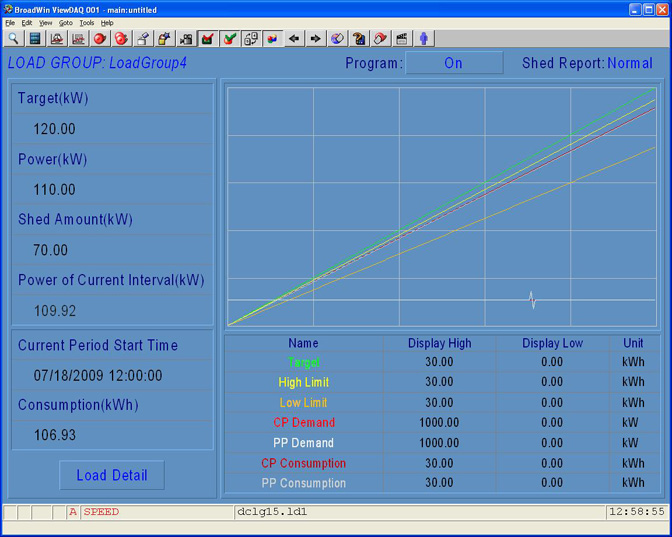
Demand Control attempts to reduce utility expenses by lowering or turning off (shedding) loads.
The loads are shed in order of priority. Low priority loads are shed first, higher priority loads later. (There are 6 priorities with priority 1 being the first to be shed).
Loads are the physical equipment that the Demand Control turns off (for example, lights, fans, motors, and air conditioners). On-Off loads are called Binary Loads. Loads that can be moved through a range are called Analog Loads. Up to 4 ranges can be specified in Demand Control for each analog load.

Figure 24.3 - Demand Control shortly after startup when lines easily labelled. 15 minute period
A Moving Window (also called a Sliding Window or Period) is used to calculate power usage continuously. The interval of this moving window can be specified, 15 minutes and 1 hour being commonly used. If 15 minutes, the algorithm works to ensure demand is less than Target Demand over the last 15 minutes at any 15-minute window in time (hence, the moving window analogy). The current moving window's KWH (Consumption) and KW (Demand) are shown in Red and labelled CP (Current Period). The Previous moving window's KWH and KW are shown in White.
Minimum On Time, Minimum Off Time and Maximum Off time are also used by the algorithm in selecting loads to shed.
The Demand Target is usually the maximum KW allowed in a Utility Contract (or Tariff). Summer, Saturday, Off-Peak and Non-Peak Season demand targets can be specified.
An High Control Limit and a Low Control Limit are specified as a percent of the Demand Target.
The High Control Limit is the actual not to exceed limit of the algorithm. Making it less than the Demand Target allows for unexpected surges in Power.
The Demand Control takes no action until Current demand exceeds the Low Control Limit.
The algorithm runs 1 per minute. Once the once the current demand exceeds the low control limit, the algorithm calculates a worse case scenario and sheds loads to avoid exceeding demand limit.
Demand Control shaves off demand peaks in the facilities demand profile for a sliding window. The sliding window (typically 15 minutes in most energy contracts) can be defined by the user. This is a continuously moving window of the last 15 minutes (or whatever is defined by the user). The previous window is also displayed.
WebAccess Demand Control is designed for electric power, but could be used for gas, steam or other energy loads.
To configure Demand Control, you define a Load Group, the meters used to measure the power consumption then define the loads associated with the Load Group object. A load group can have hundreds of loads associated with it. Typically it has only one kilo-watt hour meter, but dozens of meters can be defined. The Demand Control expects the meter to be in KiloWatt-hours. If only a kilowatt meter is available, an Accumulation Tag in WebAccess could be used to generate the KiloWatt-hours. Kilo-Watt meter input is also used by the algorithm
The Demand Control is implemented using Blocks. Each Load has a Block created by WebAccess Configuration. These Blocks run on the SCADA node. Each load can be associated with only one Load Group (assign a load to one Load Group only. There can be hundreds of Load Groups defined for a SCADA node, although typically there is one per building. The SCADA node also performs the Demand Control Algorithm.
Note - The Blocks are named for the Loads. Do not name a Load after an existing IO tag or that IO tag will be erased or corrupted.
Tariffs are a way to specify different Target Demands. Currently Peak, Off Peak and Half-Peak Saturday are supported. These are demand based on the Day of the Week. Each Tariff has its own peak demand target level. Only one Tariff is active at any one time. This allows the Demand Control to take into account multiple tariffs provided by some utility companies (for example, cheaper power on weekends).
It is recommended to balance and shed loads manually before turning on Load Control if Demand is significantly above Target to avoid aggressive shedding by the algorithm on start up.

Figure 24.3 - Demand Control in Normal operation: High Limit, Current Period KWH and Previous Period KWH lines close or overlapping